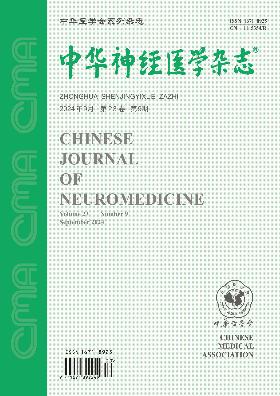Association of degrees of leukoaraiosis severity with prognoses of patients with acute anterior circulation large-artery occlusive stroke after mechanical thrombectomy
Q4 Medicine
引用次数: 0
Abstract
Objective To assess whether degrees of leukoaraiosis (LA) severity is associated with prognoses of patients with acute anterior circulation large-artery occlusive stroke after mechanical thrombectomy. Methods Clinical data of patients with acute anterior circulation large-artery occlusive stroke who underwent mechanical thrombectomy in our hospital from January 2016 to August 2017 were collected. The subjects were divided into non-to-moderate LA group and severe LA group according to preoperative degrees of LA severity; the baseline data, successful reperfusion rate, and symptomatic intracranial hemorrhage rate within 24 h of surgery, good prognosis rate 90 d after surgery(modified Rankin scale [mRS] scores≤2) and mortality 90 d after surgery were analyzed. According to the prognoses, the patients were divided into good prognosis group and poor prognosis group; univariate regression analysis and multivariate Logistic regression analysis were used to evaluate the relations of degrees of LA severity with prognoses 90 d after surgery. Results In these 146 patients, 100 patients were into the non-to-moderate LA group and 46 patients were into the severe LA group. As compared with patients in the non-to-moderate LA group, patients in the severe LA group had significantly older age (70.50 [59.75, 79.75] years vs. 79 [73, 82] years), significantly higher baseline NIHSS scores (20[16, 25]) vs. 22 [18, 28]), significantly higher rate of symptomatic intracranial hemorrhage 24 h after surgery (11.0% [11/100]) vs. 26.1% [12/46]), statistically higher mortality rate 90 d after surgery (14.0%[14/100]) vs. 14.0% [14/46]), significantly lower successful reperfusion rate (97.0% [97/100] vs. 84.8% [39/46]), and statistically lower good prognosis rate (54.0% [54/100] vs. 21.7% [10/46], P<0.05). Among the 146 patients, 64 had good prognosis and 82 had poor prognosis; univariate analysis showed that as compared with than those from the good prognosis group, patients from the poor prognosis group had significantly older age (70.50 [59.75, 79.75] years old vs. 79 [73, 82] years old) and statistically higher baseline NIHSS scores (20 [16, 25] vs. 22 [18, 28]), and significantly higher proportion of central source embolism by TOAST etiology classification (68.8% [44/64] vs. 76.8%[63/82]) and proportion of severe LA (15.6% [10/64] vs. 43.9% [36/82], P<0.05); multivariate Logistic regression analysis showed that severe LA (OR=3.109, 95%CI: 1.241-7.788, P=0.015), age, baseline NIHSS scores, and TOAST etiology classification were all independent risk factors for poor prognosis 90 d after surgery (P<0.05). Conclusion Severe LA may be associated with poor prognosis of patients with acute anterior circulation large-artery occlusive stroke after mechanical thrombectomy. Key words: Ischemic stroke; Thrombectomy; Leukoaraiosis; Prognosis急性前循环大动脉闭塞性脑卒中机械取栓后白质病变严重程度与预后的关系
目的探讨急性前循环大动脉闭塞性脑卒中患者机械取栓后脑白质病变严重程度与预后的关系。方法收集2016年1月至2017年8月我院急性前循环大动脉闭塞性脑卒中机械取栓患者的临床资料。根据术前LA严重程度分为LA非至中度组和LA重度组;分析基线资料、术后24 h内再灌注成功率、症状性颅内出血率、术后90 d预后良好率(改良Rankin量表[mRS]评分≤2分)及术后90 d死亡率。根据预后情况将患者分为预后好组和预后差组;采用单因素回归分析和多因素Logistic回归分析评价LA严重程度与术后90 d预后的关系。结果146例患者中,非至中度LA组100例,重度LA组46例。与非至中度LA组相比,重度LA组患者的年龄明显增大(70.50[59.75,79.75]岁vs. 79[73,82]岁),基线NIHSS评分显著增高(20[16,25])vs. 22[18,28]),术后24 h有症状性颅内出血发生率显著增高(11.0% [11/100])vs. 26.1%[12/46]),术后90 d死亡率显著增高(14.0%[14/100]);再灌注成功率(97.0%[97/100]比84.8%[39/46]),良好预后率(54.0%[54/100]比21.7% [10/46],P<0.05)。146例患者中,预后好64例,预后差82例;单因素分析显示,与预后良好组相比,预后不良组患者的年龄明显大于预后良好组(70.50[59.75,79.75]岁vs. 79[73, 82]岁),NIHSS基线评分显著高于预后良好组(20 [16,25]vs. 22 [18, 28]), TOAST病因分类中心源性栓塞比例(68.8% [44/64]vs. 76.8%[63/82])和重度LA比例(15.6% [10/64]vs. 43.9% [36/82], P<0.05);多因素Logistic回归分析显示,重度LA (OR=3.109, 95%CI: 1.245 ~ 7.788, P=0.015)、年龄、NIHSS基线评分、TOAST病因分型均为术后90 d预后不良的独立危险因素(P<0.05)。结论严重LA可能与急性前循环大动脉闭塞性脑卒中机械取栓术后预后不良有关。关键词:缺血性脑卒中;血栓切除术;Leukoaraiosis;预后
本文章由计算机程序翻译,如有差异,请以英文原文为准。
求助全文
约1分钟内获得全文
求助全文
来源期刊

中华神经医学杂志
Psychology-Neuropsychology and Physiological Psychology
CiteScore
0.30
自引率
0.00%
发文量
6272
期刊介绍:
 求助内容:
求助内容: 应助结果提醒方式:
应助结果提醒方式:


